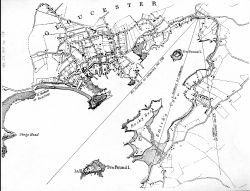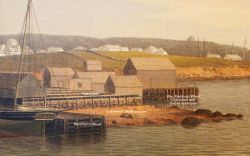loading 
Fitz Henry Lane
HISTORICAL ARCHIVE • CATALOGUE RAISONNÉ • EDUCATIONAL RESOURCE
An online project under the direction of the CAPE ANN MUSEUM
An online project under the direction of the CAPE ANN MUSEUM
Catalog entry
inv. 23
Gloucester Harbor
1847 Oil on canvas 28 1/2 x 41 in. (71.8 x 104.1 cm) Signed and dated lower right: F H Lane, 1847 [could have been FHL originally]
|
Related Work in the Catalog
Supplementary Images
Provenance (Information known to date; research ongoing.)
the Artist, Gloucester, Mass.
Samuel H. Mansfield, Gloucester, Mass.
Cape Ann Museum, Gloucester, Mass., May 9, 1949
Exhibition History
National Gallery of Art, Washington, District of Columbia, Paintings by Fitz Hugh Lane, May 15–September 5, 1988., no. 10, ill., p. 27.
Traveled to: Museum of Fine Arts, Boston, Mass., 5–31, 1988.
Traveled to: Museum of Fine Arts, Boston, Mass., 5–31, 1988.
Cape Ann Historical Association, Gloucester, Massachusetts, Training the Eye and Hand: Fitz Hugh Lane and Nineteenth Century American Drawing Books, September 17, 1993–January 29, 1994.
Published References
Wilmerding, John. Fitz Hugh Lane, 1804–1865: American Marine Painter. Salem, MA: The Essex Institute, 1964., fig. 11, p. 37.
Wilmerding, John. Paintings by Fitz Hugh Lane. Washington, DC: National Gallery of Art; in association with Harry N. Abrams, 1988., no. 10, ill. in color, p. 27.
Slawek, Tadeusz. Revelations of Gloucester: Charles Olson, Fitz Hugh Lane, and Writing of the Place. New York: Peter Lang, 2003., Il. 2.
Worley, Sharon. "Fitz Hugh Lane and the Legacy of the Codfish Aristocracy." Historical Journal of Massachusetts 32, no. 1 (Winter 2004)., fig. 4, p. 85. ⇒ includes  text
text
Craig, James. Fitz H. Lane: An Artist's Voyage through Nineteenth-Century America. Charleston, SC: The History Press, 2006., pl. 4.
Lovell, Margaretta. Painting the Inhabited Landscape: Fitz H. Lane and the Global Reach of Antebellum America. University Park: Pennsylvania State University Press, 2023., fig. 5.
.jpg)
.jpg)
.jpg)
.jpg)
.jpg)
.jpg)
.jpg)



Commentary
This is one of the great early Inner Harbor scenes in which Lane tries to capture his whole world in one view. The expansive panorama encompasses the whole of Gloucester's Inner Harbor: the wharves on both sides, Five Pound Island with its small fish shacks in the center of the view, and, in the distance, Ten Pound Island with its lighthouse. The dark arc of the foreground beach acts as the proscenium for a theatrical stage on which all the vessels and buildings enact their individual roles in the daily drama of a working harbor.
The view is taken from the shore at the head of the harbor—its innermost recess (see map below). On the beach in the foreground the center figure is tarring the seams of the boat he has just caulked using the material and tools from the box to his left. The man on the right chops wood for the black kettle that is now heating the tar to make it spread more easily. The man on the left is levering a large timber to follow the one already headed towards the water. These are pilings to be driven into the mud to hold the large rocks piled on the beach. The men are making a new cob wharf like the one shown in the extreme left-middle ground. The two wharves on the left side of the painting are the best depictions of crib and cob wharves to be found in Lane's Gloucester Harbor scenes.
The vessels in the harbor (mostly schooners with a brig directly behind Five Pound Island) are in various stages of anchoring or making themselves fast for the night. The tide is at dead low, and Lane is illustrating the problem with the Inner Harbor of the 1840s: there is not enough deep water at low tide to accommodate larger vessels. Note the vessel tied to the wharf on the far right. It sits entirely on the beach, although it will float on a high tide. The schooner on the left is leaning on its side in the shallow water and will need a few more feet of tide in order to float.
Lane is showing the beginnings of a new era of wharf building that would accelerate over the next two decades until almost the entire harbor was ringed with wharves. They extended far enough into the harbor to take vessels in all tides, greatly increasing the capacity and efficiency of the harbor. Fish could then be unloaded directly onto the wharves and flakes (fish-drying racks) shown beside the buildings on the left and on Five Pound Island in the center.
Lane did a number of similar paintings of harbor views between 1847 and 1850: The Fort and Ten Pound Island, Gloucester, Massachusetts, 1847 (inv. 271), View of Gloucester Harbor, 1848 (inv. 97), Gloucester Inner Harbor, 1850 (inv. 240), and The Fort and Ten Pound Island, Gloucester (Harbor Scene), 1848 (inv. 58). They all have a panoramic scale; one can almost see the curve of the earth in their scope. They are full of a fascinating array of activities—the everyday business of a working harbor. They have a fresh, crystalline quality of light that communicates the optimism of a town creating a new identity after the many decades of economic hardship brought on by the War of 1812.
– Sam Holdsworth
A Visual Guide to the Painting
Lane’s move from Boston back to Gloucester (late 1840s) marked a flurry of canvases depicting the town and its harbor from many viewing points. While the scenes of Harbor Cove are the most numerous and best known, other locations along the harbor shoreline provided views of great beauty and historical importance. One of Lane’s finest harbor depictions appears to be unique in its viewpoint, with no other views related to it. The painting has been simply titled Gloucester Harbor, but its drawing, titled Looking Outward from Head of Harbor (in Lane’s own handwriting), is a precise description of the location. Today, this location is still called “Head of the Harbor," though its scenic beauty is greatly diminished.
All of the shoreline in the painting is related to a reviving fishing industry in mid-nineteenth-century Gloucester as the Inner Harbor’s shallow bottom became increasingly problematic to merchants in the foreign trade, whose ever-larger ships needed wharfage in a deeper harbor. The Head of the Harbor became the last part to accommodate fishing vessels which, being smaller, were less hampered by the inconvenience and accepted groundings at low tide as part of doing business.
Gloucester Harbor, 1847 (inv. 23)
(see key to labelled image below)
The foreground illustrates common uses of the intertidal zone at low tide:
1. A dory—then a boat used in the shore fisheries (dory trawling using long lines was only being introduced to American fishermen at this time)—is being readied for the day’s work. Not enough gear is present to tell what that work will be. Lobstering, working fish traps and gillnets, and hand-line fishing were the most common types of dory fishing.
2. The two logs being hauled ashore are possibly for spars (finished masts were commonly delivered this way). More likely, they will be used as wharf spiles (pilings), either for a new wharf or as replacements for old, worm-eaten spiles.
3. A yawl boat is having its bottom seams payed with hot pitch, following the stripping and replacement of old caulking. Note the basket of caulking tools to the left of the boat.
4. Hot pitch for paying bottom seams is simmering in the kettle while the caulker’s assistant splits firewood.
5. A sloop-load of granite blocks has been off-loaded on the shore in preparation for building a new wharf or bulkhead pier. These blocks are so irregular in shape because they were probably split to size from field stones or quarry tailings. They are most likely intended for building a cob wharf, examples of which can be seen in this painting.
Although the painting shows this area in an early stage of development, there are several wharves lining the shore whose owners can be identified, many of them in the early years of long and successful careers:
6. Marchant’s Wharf is a fine example of a crib wharf, built up in layers called cribs, which were also used to frame the foundations of cob wharves. Both types of wharf construction are centuries old, many examples of which have survived to the present, though often concealed by subsequent “improvements.”
7. The adjoining flake yard’s waterfront is retained by a bulkhead pier of typical cob wharf construction. The siding is rubble stone, some of which has been split to form flat sides and then pieced together in an irregular pattern. The top is capped by a timber deck, with vertical spiles serving as supports for the stone siding. The horizontal structures atop the pier are fish flakes—wooden racks on which split salt cod were laid out to dry.
8. William Parkhurst’s wharf is another cob wharf (in the form of a finger pier) with a timber deck extension supported by spiles.
9. This barren unnamed shoreline obscures the oldest part of the East Gloucester community, whose houses rise behind it. Around its far end are the wharf of Benjamin Parsons & Co. and a complex of wharves, buildings, and a flake yard belonging to Samuel Wonson, whose family was one of the leading names in Gloucester’s fishing industry.
10. Five Pound Island was so named in colonial times for sheep pounds to keep rams when not needed for breeding. In Lane’s time, it had fish shacks and a flake yard.
11. Rocky Neck saw little use by the fishing industry until after a marine railway for repair and maintenance of fishing vessels was built at its northeast end in 1886.
12. Ten Pound Island was named, as Five Pound Island was, for sheep pounds, not for a supposed sum paid to Native Americans by early settlers. The lighthouse was first activated in 1821.
13. Frederick G. Low’s wharf at the head of Duncan’s Point. To the left of it is Harbor Rock with a wooden platform on top.
14. Wharf and fish house of S. W. Brown.
15. Wharf of George Friend & Co.
16. Wharf of George Parkhurst.
Two vessels—one afloat, the other aground—are of particular note:
17. A small example of a Georges Bank hand-line schooner, probably no more than fifty-five feet long, not counting spars, and drawing about seven feet. Her situation clearly shows the low-tide depth problem at this end of the Inner Harbor.
18. A merchant brig is in the process of clewing-up and furling sail as she comes to anchor off the southwest side of Ten Pound Island. In that area, there is adequate depth for anchorage about 650 feet from shore at low tide.
– Erik Ronnberg